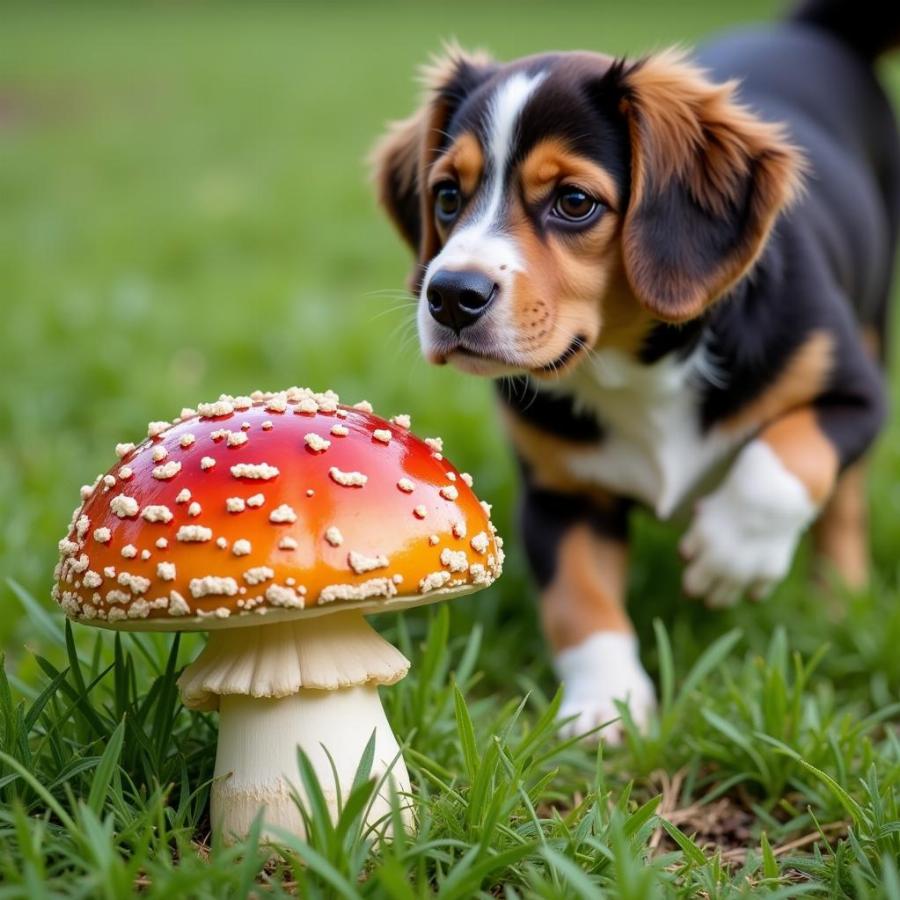Dog owners need to be aware of the potential dangers lurking in their backyards, and one such hazard is the stinkhorn mushroom ( Phallus impudicus or Mutinus caninus). While not deadly, these fungi can cause significant gastrointestinal upset in dogs if ingested. This article delves into everything you need to know about dog stinkhorn mushroom encounters, from identification to prevention and treatment.
Recognizing the Stinkhorn Mushroom
Stinkhorn mushrooms are easily identifiable by their unique, somewhat phallic, appearance and their foul odor, often described as resembling rotting meat. This pungent smell attracts flies and other insects, which aid in spore dispersal. They typically emerge from wood debris or mulch in warm, humid weather. The Mutinus caninus, or dog stinkhorn, is slightly smaller and more slender than the Phallus impudicus. Knowing what these mushrooms look like is the first step in protecting your dog.
Why are Stinkhorn Mushrooms Dangerous to Dogs?
Though not typically fatal, stinkhorn mushrooms can cause a range of unpleasant symptoms in dogs. The sticky gleba (spore mass) is particularly attractive to dogs due to its strong odor and sweet taste. However, this gleba can cause severe gastrointestinal distress, including vomiting, diarrhea, and excessive drooling. In some cases, dogs might exhibit symptoms like lethargy, loss of appetite, and abdominal pain.
What are the signs of stinkhorn mushroom poisoning in dogs? While vomiting and diarrhea are the most common, keep an eye out for any changes in behavior, like lethargy or refusal to eat. If you suspect your dog has ingested a stinkhorn mushroom, contact your veterinarian immediately.
Preventing Stinkhorn Mushroom Ingestion
The best way to protect your dog from stinkhorn mushrooms is to prevent access to areas where they might grow. Regularly inspect your yard and remove any mushrooms you find. Consider using pet-safe fungicides to discourage mushroom growth. Training your dog to “leave it” can also be incredibly helpful in preventing them from eating potentially harmful substances.
How can I keep stinkhorn mushrooms out of my yard? Maintain a clean yard free of decaying organic matter. Ensure proper drainage to avoid excessively damp areas. Regularly raking and removing debris can also help prevent mushroom growth.
 Dog Avoiding Stinkhorn Mushrooms in Yard
Dog Avoiding Stinkhorn Mushrooms in Yard
What to Do If Your Dog Eats a Stinkhorn Mushroom
If your dog ingests a stinkhorn mushroom, contact your veterinarian immediately. They may induce vomiting or administer activated charcoal to absorb the toxins. The sooner you seek treatment, the better the outcome for your dog. Do not attempt to treat your dog at home without professional guidance.
Is there a home remedy for dog stinkhorn mushroom ingestion? No, there are no safe or effective home remedies. Contacting your veterinarian is crucial for proper diagnosis and treatment.
Beyond the Stinkhorn: Other Toxic Mushrooms
While stinkhorn mushrooms are a concern, they are just one of many potentially toxic mushrooms for dogs. It’s essential to be aware of other dangerous fungi, like Amanita species, which can be deadly. Educate yourself on the various types of mushrooms that grow in your area and be vigilant in keeping your dog away from them.
Conclusion
Dog stinkhorn mushroom encounters are unpleasant, but with vigilance and prompt action, the effects can be minimized. By learning to identify these fungi, taking preventative measures, and knowing what to do in case of ingestion, you can keep your canine companion safe and healthy. Remember, prompt veterinary care is crucial if your dog consumes a stinkhorn mushroom.
FAQ
- Are all mushrooms toxic to dogs? No, not all mushrooms are toxic, but many are, and it’s best to err on the side of caution.
- Can dogs die from eating stinkhorn mushrooms? While rare, severe reactions can occur, so it’s essential to seek veterinary attention.
- How long do stinkhorn mushroom poisoning symptoms last in dogs? Symptoms usually subside within 24-48 hours with appropriate treatment.
- What are the most common symptoms of mushroom poisoning in dogs? Vomiting, diarrhea, drooling, lethargy, and loss of appetite are common signs.
- How can I prevent my dog from eating mushrooms in my yard? Regular yard maintenance, training, and pet-safe fungicides can help.
- What should I do if I see a stinkhorn mushroom in my yard? Remove it immediately and dispose of it safely.
- Are there any long-term effects of stinkhorn mushroom poisoning in dogs? Generally, no, with prompt treatment, dogs recover fully.
Beaut Dogs: Your Trusted Resource for Canine Care
Beaut Dogs is your one-stop shop for all things canine, offering comprehensive and reliable information on dog breeds, care, and well-being. From breed-specific guides to expert advice on health, nutrition, and training, we empower dog owners to provide the best possible care for their furry friends. When in doubt or needing personalized assistance, contact Email: [email protected] for expert advice from Beaut Dogs. We are committed to providing you with accurate and helpful information to ensure your dog’s health and happiness. Visit https://beautdogs.com today to explore our extensive resources.